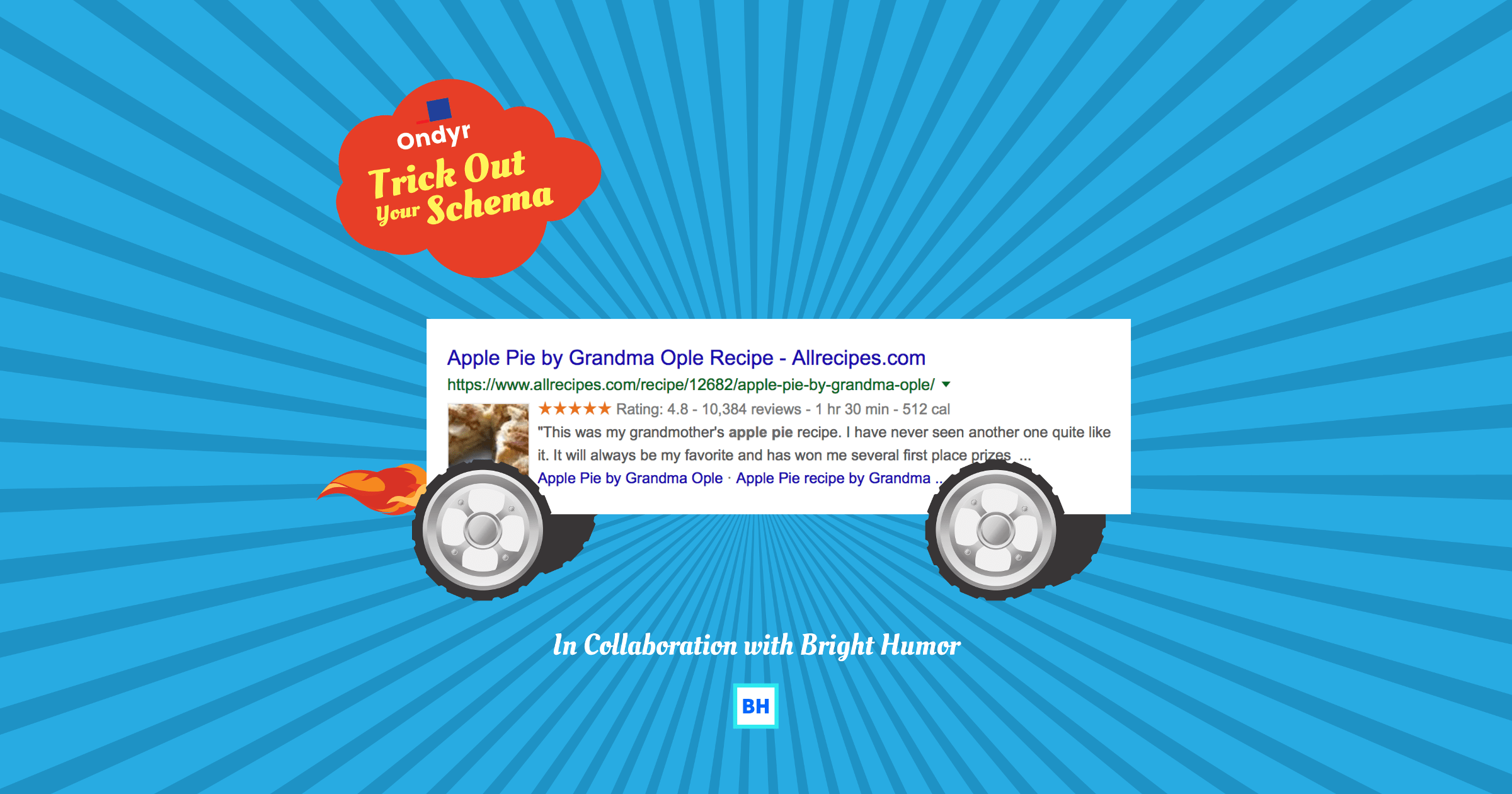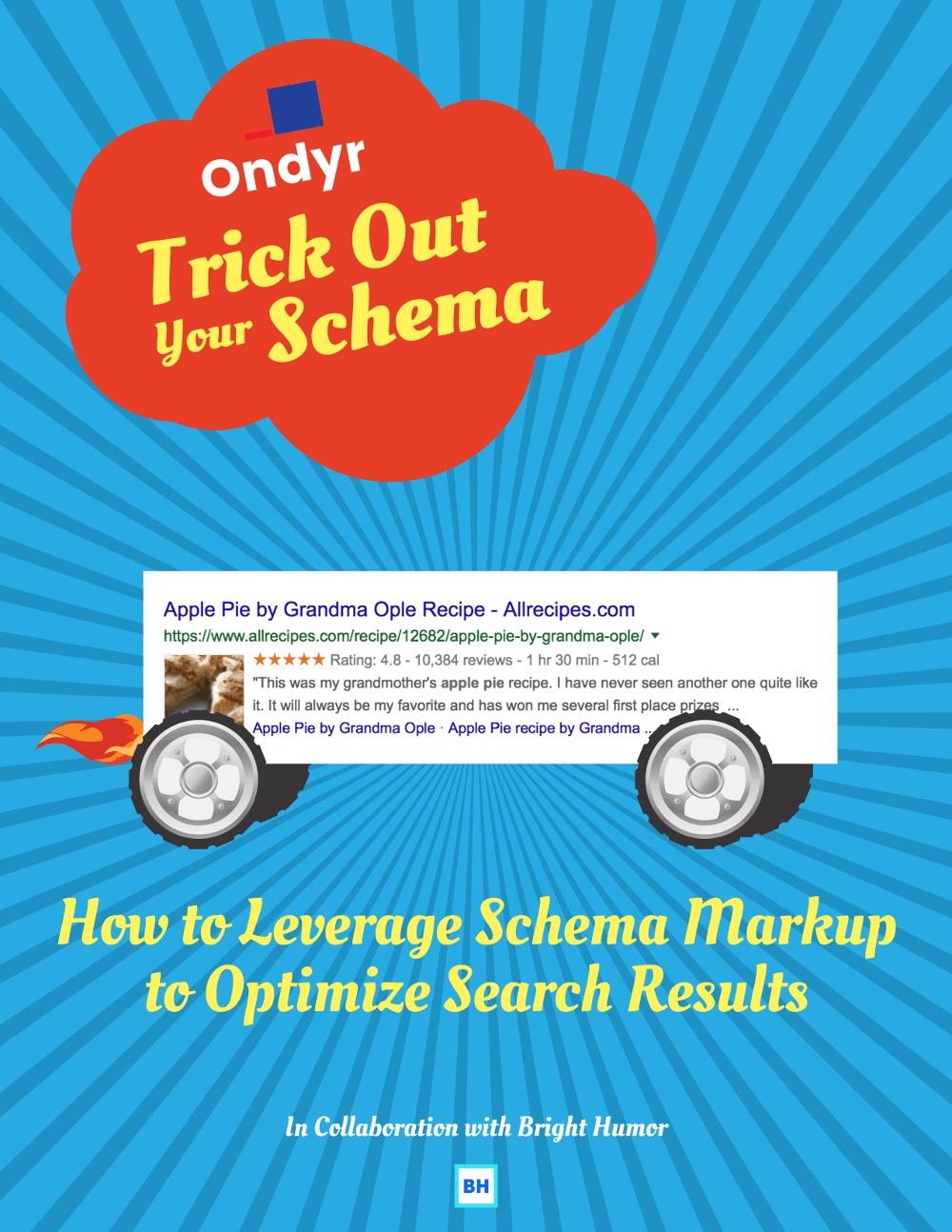
Trick Out Your Schema
How to Leverage Schema Markup to Optimize Your Search Results, SEO, and Structured Data
Introduction
Welcome to our Trick Out Your Schema guide!
This guide will cover schema markup, its many search engine optimization (SEO) benefits, and how you can use schema markup to trick out your Google search listings. Schema for structured data is a focus of Google, and whatever is a priority for Google, should probably be a priority for you.
At Ondyr, we’ve seen schema increase organic search traffic, increase click-through-rate (CTR) of Google listings, and improve brand presence. Also, schema markup is relatively new, which means that you can gain an advantage over competitors who are not fully leveraging it. Hah! Non-schema suckers!
This guide is a crash course on schema markup and structured data as it relates to SEO. We’ll go into the necessary details without leaving you lost in the weeds with coding jibber-jabber. Our goal is to offer a framework of information about schema that will allow you to effectively strategize where you should implement schema within your website.
Whether you work independently as a consultant, at an agency, in-house, or do SEO for your own site, this guide should be useful. We’ll set out to cover the background of what schema is, why it’s important, the main benefits, common types found in search, and additional resources to learn more.
Most importantly, we’re going to explain why you need to trick out your schema!

Answers to your biggest questions - all without a click
Chapter 1: The New SEO Landscape
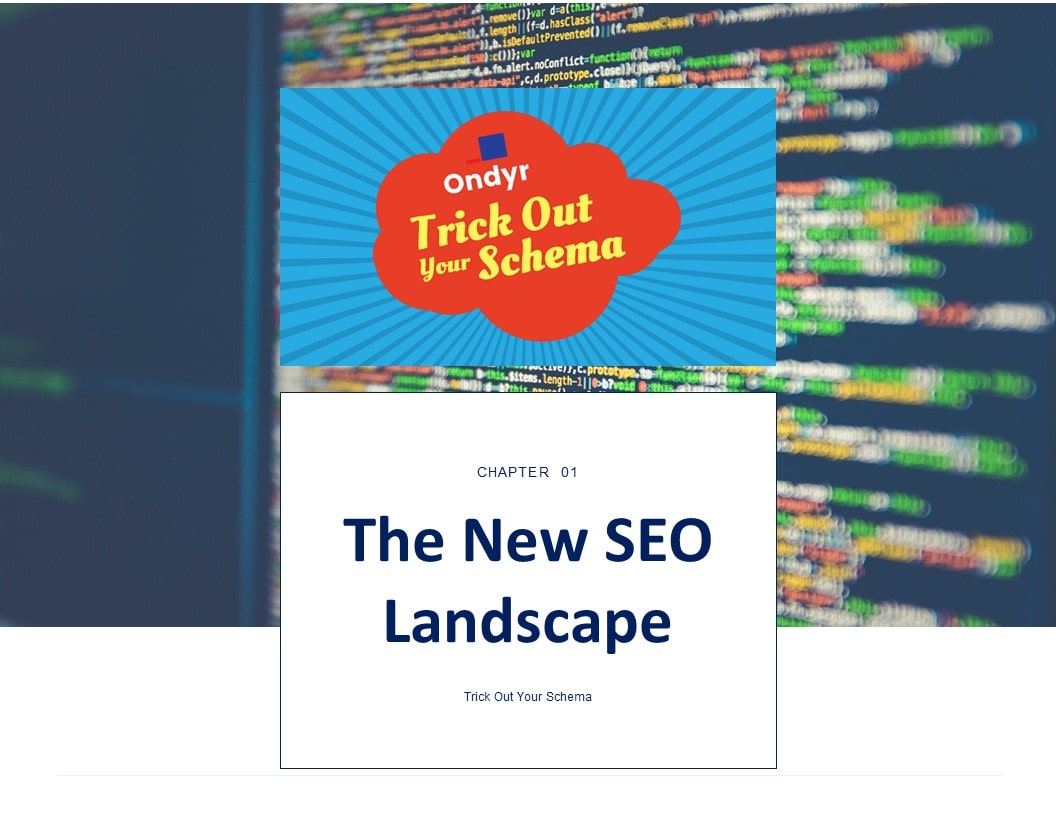
First, let’s set the context for why schema and structured data are both important.
Every day, it seems like there’s some new information box, visual element, or thing in Google search results. This is the direction Google is headed. Embrace it.
You’ve seen those information boxes with excerpts or quick answers on top of search results. This area is referred to as ‘position zero’ because it’s shown before the first result.
Being in position zero means you are The Chosen One – at least in the eyes of Google.
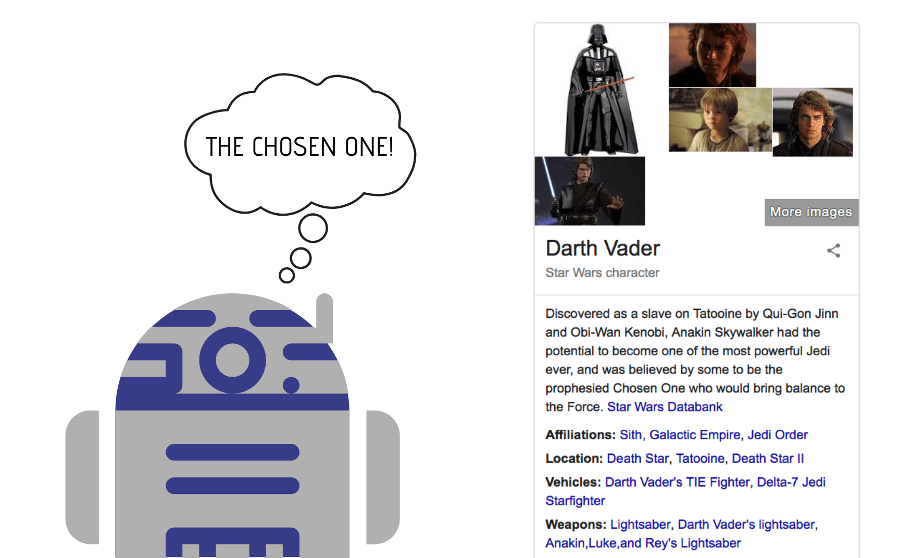
Google search results are crowded with up to four ads, a map pack, and other visual elements.
Sometimes you have to scroll two or three times just to get to the first organic result, especially on mobile. Talk about a thumb workout!
Thumbs don’t typically scroll past the first page in Google, so you need to get competitive about landing one of those top slots with a search result that’s enticing enough to click.

Google is no longer ten blue text links. Much more is going on in the Search Engine Results Pages (SERPs) these days than AskJeeves would’ve ever expected. Schema is now a critical aspect of SEO and some say it’s the future.
The most conspicuous way that schema can help your website is in delivering rich results with all of the schema bling you need to shine bright like a diamond and catch the thumbs of potential customers!
Schema markup can also show up in the Knowledge Panel, which is the large information box on the right-hand side with information on organizations, public figures or other notable entities.
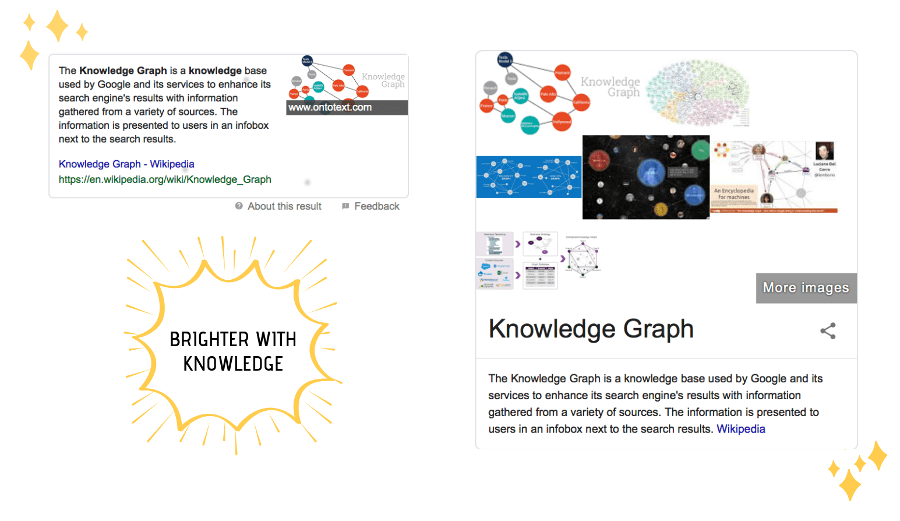
Google wants to keep you on Google longer and provide you with an answer right in the search results without having to click through to another site. This is a trend that is gaining momentum without an end in sight because it’s working for Google.
According to SparkToro:
- More than 50% of Google Searches result in 0 clicks to another site
- 45.3% go to regular organic listings, 4.4% go to Google Ads, and 50.3% don’t result in a click
Since clicks to regular organic search listings are decreasing percentage-wise, you’ll want to increase your chances of gaining clicks with an attention-grabbing rich result.
If there isn’t a click, the searcher may have found what they need directly on the search results page or found that the search results weren’t relevant, and therefore, redid the search with a different keyword.
Weather queries are a typical example of ‘no-click searches’. If you’re searching for weather, you’ll be presented with a large box with the most pertinent weather statistics that you need to know: temperature, precipitation, 10-day forecast, hourly forecast, etc.
Therefore, no one is really clicking the first organic result in these cases. Even though it’s ranking in the first position, that site probably is receiving a very low click-through-rate, unless it’s another ‘Storm of the Century’.
It’s debatable whether this trend is a net positive for content publishers, for SEO, and for users. It’s a double-edged sword. On one hand, most rich results provide an opportunity for your brand to stand out in the rankings above organic search results and earn more clicks. On the other hand, some rich results could completely satisfy the searcher’s query resulting in one less click to your site. What’s not debatable is that it’s a trend that’s here to stay, so don’t fight it. Just submit to the trend, just like you did with selfies and the Kardashians.
Embrace the glam life and trick out your schema!
For most, the goal of schema markup is to be in as many rich results as possible. So how can you get these rich results with images, rating stars and other visual enhancements?
Keep reading.
Chapter 2: What is Schema Markup?
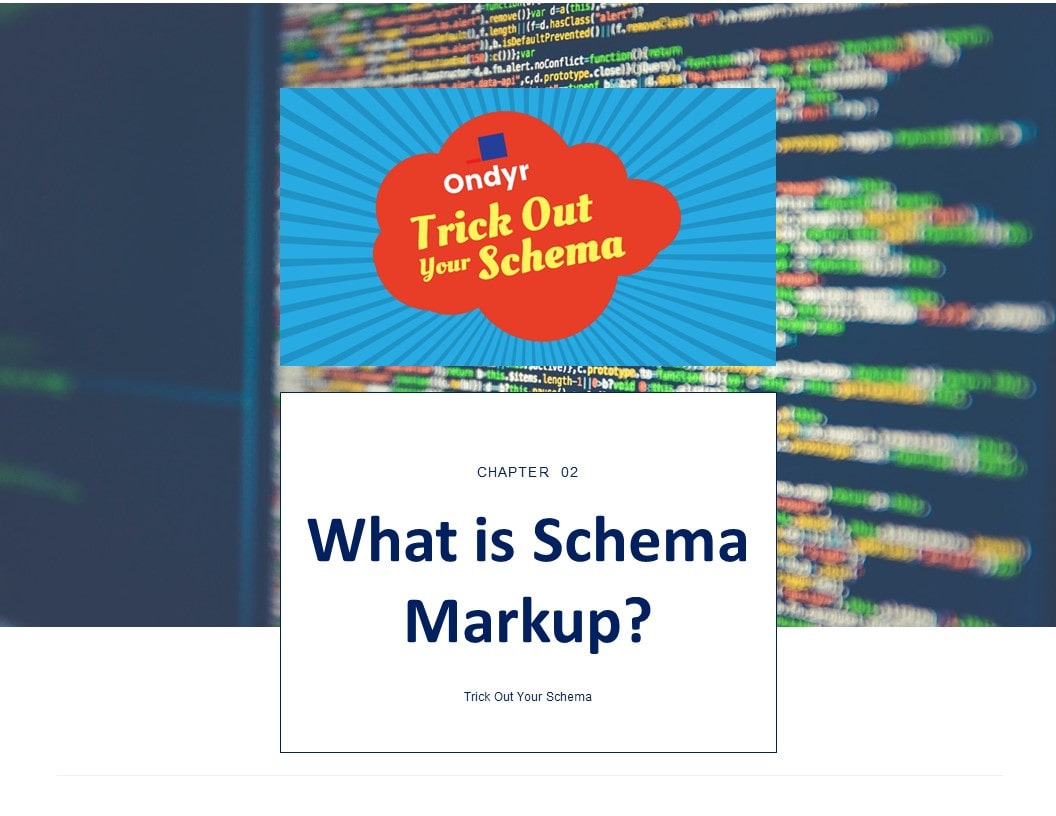
Schema markup for SEO is a method of getting rich results in search by organizing free form website content into structured data making it easier for search engines to understand your site.
Schema is the way your website becomes eligible for rich results in search engines (although in some situations Google pulls from the content itself but still recommends to use markup).
Let’s cover some examples of schema in action. For example, this GoodReads rich result for the book Deep Work shows an image, rating stars and number of votes directly in search:

Adding schema to a page doesn’t guarantee that you’ll receive a rich result, but schema that’s correctly implemented dramatically increases your odds of receiving rich results for relevant search queries.
Schema is also used to organize free form website content into structured data that’s easier for search engines to understand. This aspect of schema’s definition speaks to how difficult Google’s job actually is to understand webpage content due to variations in layout, format, information, topics covered, etc.
While Google is excellent at crawling pages and parsing the data to understand the content, it isn’t perfect. As you can see in the below search query, one result is not like the others.
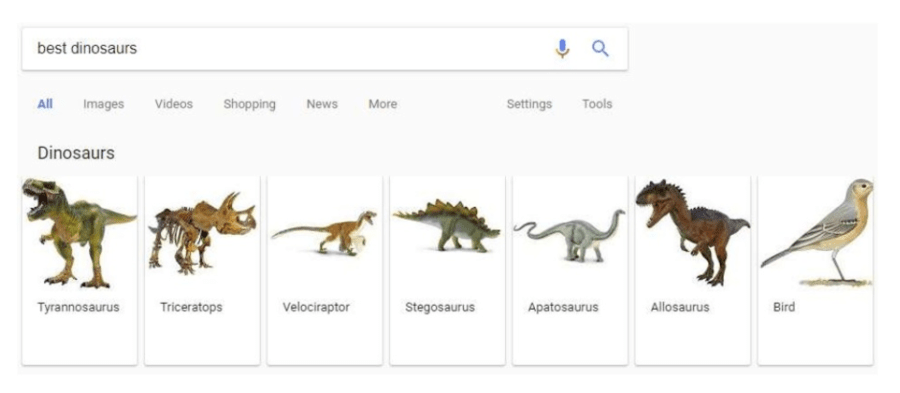
Sometimes you might see that an inaccurate image or not-quite-right answer shows up that doesn’t make sense based for your search query. How human of you, Google.

At its core, schema tells Google and other search engines explicitly what specific webpage content is all about. It can decipher the main article image, the date it was last modified, its average rating, and so on.
Google loves schema, because Google hates guessing games.
Schema is implemented through code on the backend of your site, and you don’t need to be a professional coder to implement it. Schema markup allows the content of your site to be turned into efficient, spreadsheet-like structured data. Take a look at this image from Google’s Rich Results Test:
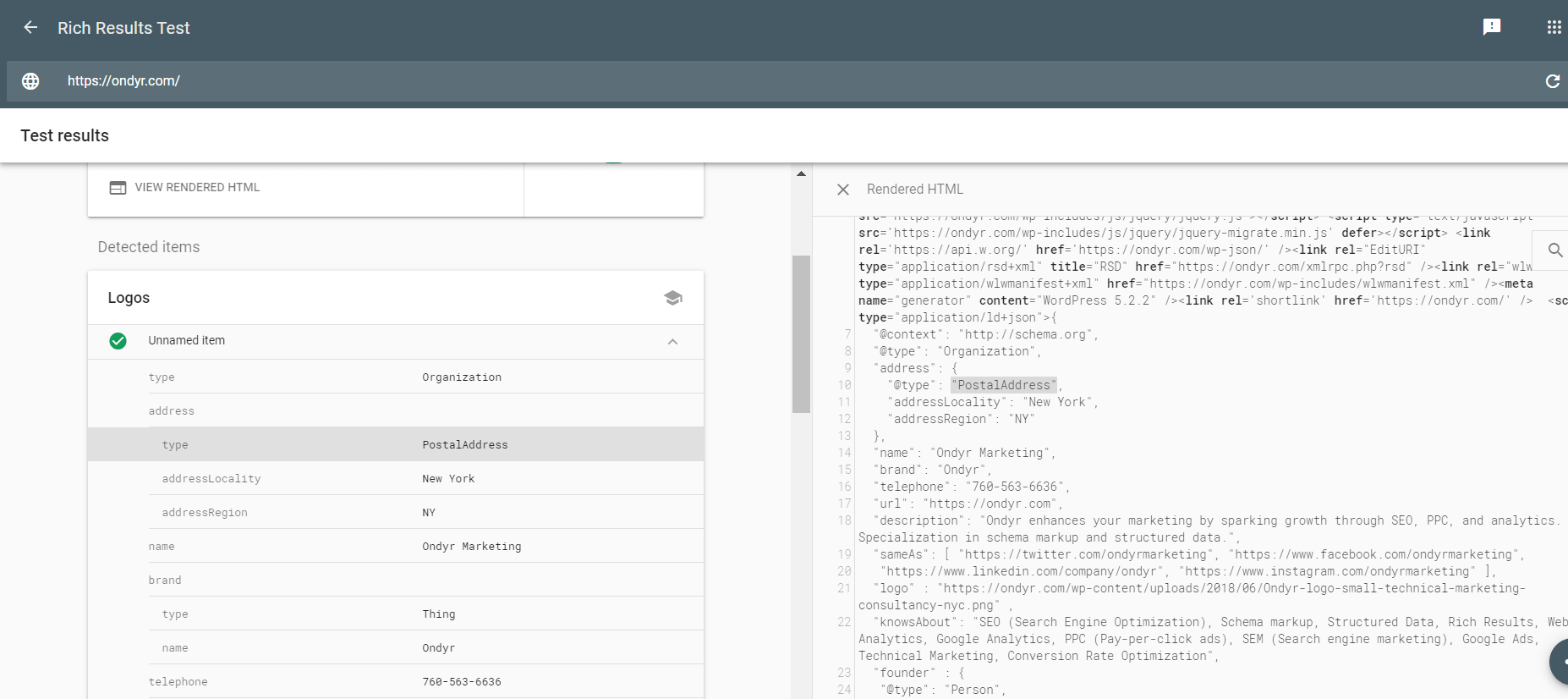
Now instead of making an educated guess, you’re telling Google exactly what it’s looking at.
Do you like what you’re seeing, Google? 😉

Structured data is essentially a list of the main properties of your webpage you are trying to clarify with information. This gives Google more confidence about what the site is about and therefore makes the site more likely to rank higher and receive a rich result.
Chapter 3: Understanding the Richness of Rich Results
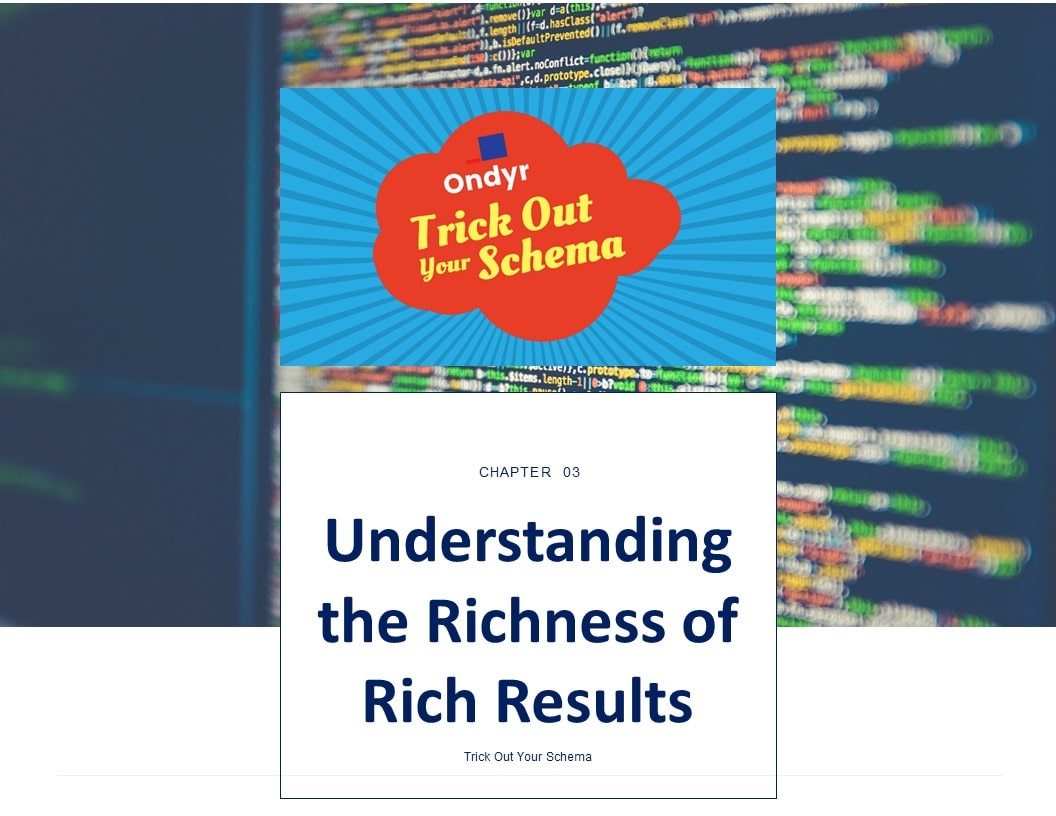
Most people want to implement schema markup for rich results. But what exactly are rich results? And what types show up in Google? This is what the next section will cover.
We’ve eluded to rich results many times but let’s take a step back and officially define the term: “A rich result is an enhanced listing in Google search results that goes beyond standard text to include visual elements like images, stars, and carousels.”
We’ll soon cover the most popular rich results, but first, here are some examples that are less common to get a sense of the breadth of schema.
There is schema markup to become eligible for Top Places carousels.
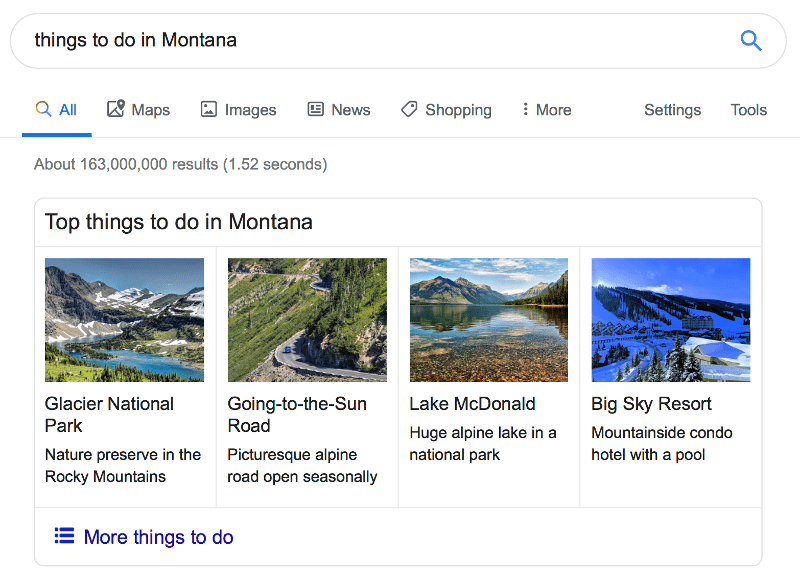
Who says there’s nothing to do in Montana? It’s like the Vegas of Mother Nature!
There’s markup to denote if a fact has been checked:

Here’s an example of schema markup for online courses:

Look at all of the extra real estate achieved in this course listing in search. Just the extra space alone is impressive (compared to a regular listing) – like a Montana range packed into Times Square!
There are enticing UX elements, links, and a lot of information to grab a thumb’s attention.
How did schema get started?
Schema.org was started in a collaborative effort by top search engines: Google, Microsoft, Yahoo, and Yandex. Since search engines created schema, they naturally want sites to use it and offer some sweet SEO benefits to sites with schema markup. After all, life is good when you’re in the good graces of search engines. The big caveat is that it can’t be spammy schema.
There is a huge number of topics and elements that you can markup. There are now 600 types of schema markup on schema.org that you can add to your website.
The best way to find a schema markup for your company or industry is to search Schema.org. There is also a full list of schema that you can browse. You might be surprised at what is possible to mark up with schema! Schema.org is the authoritative source but is also very dry and technical.
At the end of the day, schema is code
Not to scare anyone, but ultimately schema markup is code on the backend that you add to your website to explicitly explain what is on your webpage.
However, you don’t have to be a coder to implement schema markup. But if you are comfortable with making slight edits to code and deploying it, you will benefit by having more options open.
If looking at code feels like looking at modern-day hieroglyphics, you should seriously consider outsourcing this project.
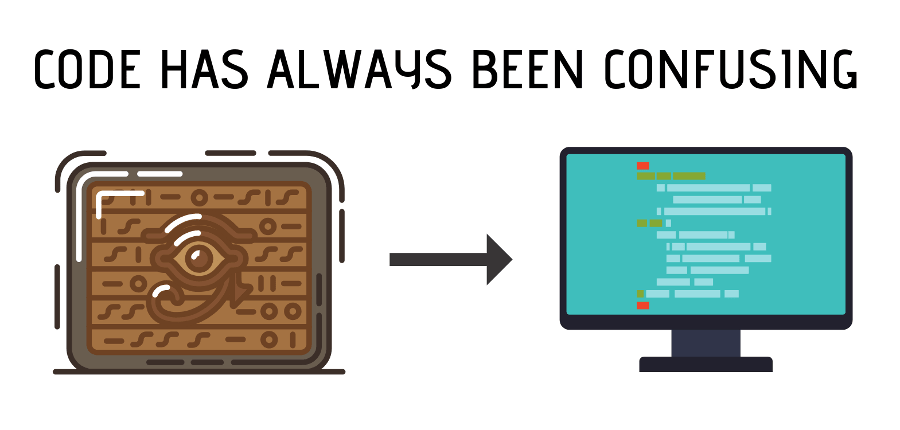
It’s highly recommended that you implement schema using the language JSON-LD (although there are other ways, such as RFDa and microdata, which we won’t cover here).
It’s also possible to spy on competitors or other sites to see how they are implementing schema. For example, want to reverse engineer a really good website for event schema? Analyze a URL for an Eventbrite event page (they have some beautiful schema markup in JSON-LD code you can then use as a template and adjust to your needs).
Almost anyone can benefit from implementing the organization schema so let’s dig into an example of that so everyone can see how schema code in JSON-LD is structured.
Here is an example of the code for organization schema:
<script type="application/ld+json">
{
"@context": "http://schema.org",
"@type": "Organization",
"address": {
"@type": "PostalAddress",
"addressLocality": "New York",
"addressRegion": "NY"
},
"name": "Ondyr Marketing",
"brand": "Ondyr",
"telephone": "760-563-6636",
"url": "https://ondyr.com",
"description": "Ondyr enhances your marketing by sparking growth through SEO, PPC, and analytics. Specialization in schema markup and structured data.",
"sameAs": [ "https://twitter.com/ondyrmarketing", "https://www.facebook.com/ondyrmarketing",
"https://www.linkedin.com/company/ondyr", "https://www.instagram.com/ondyrmarketing" ],
"logo" : "https://ondyr.com/wp-content/uploads/2018/06/Ondyr-logo-small-technical-marketing-consultancy-nyc.png" ,
"knowsAbout": "SEO (Search Engine Optimization), Schema markup, Structured Data, Rich Results, Web Analytics, Google Analytics, PPC (Pay-per-click ads), SEM (Search engine marketing), Google Ads, Technical Marketing, Conversion Rate Optimization",
"founder" : {
"@type": "Person",
"name": "Stephen Stanczak"
},
"foundingDate" : "2018-05-01",
"contactPoint" : {
"@type" : "ContactPoint",
"telephone" : "+1-760-563-6636",
"contactType" : "customer service"
} ,
"areaServed" : "US",
"email" : "[email protected]"
}
</script>
Using this schema markup, Google can parse the following structured data:
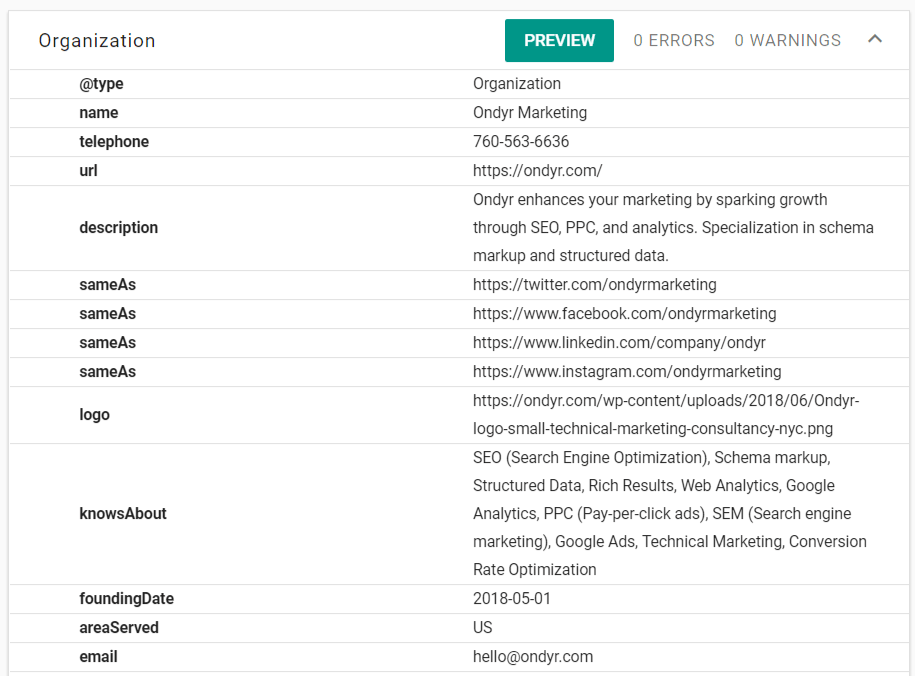
Now that you know how schema code added to your site leads to structured data, let’s illustrate how it leads to rich results seen by the user in the great circle of schema markup.
Here is an example of a rich result powered by schema:

It looked so delicious, we had to click it!
The schema markup on the backend feeds into the rich result information on the front-end. Below, you can see where the Image and Total Time were pulled from after the schema markup was parsed by Google (the rating and review information isn’t shown below but is included in the full list).
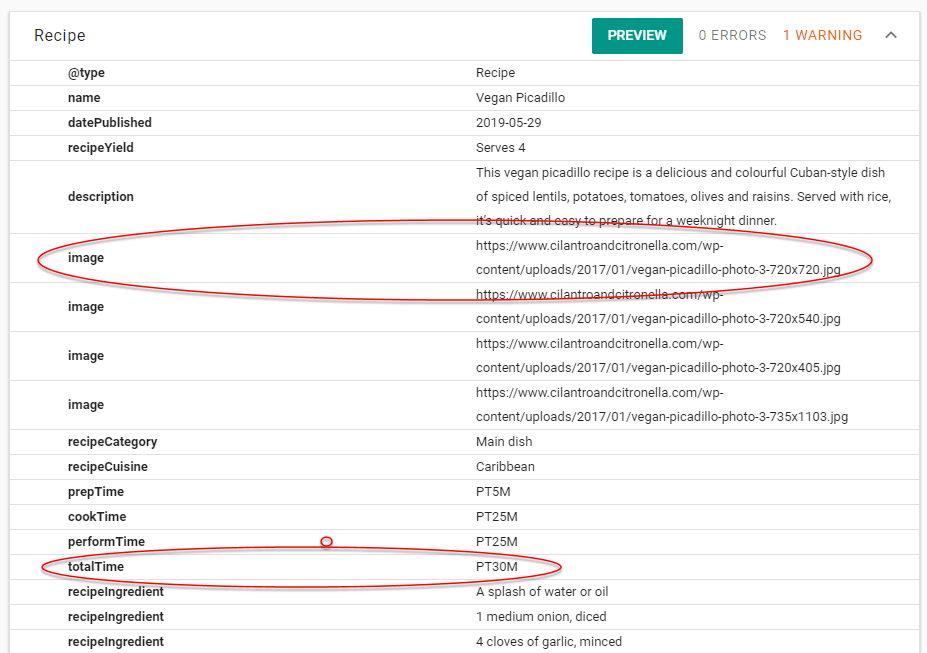
While there are 600 types of schema markup, only 30 rich results in Google are currently powered by schema markup.
These are the schemas to focus on if you’re mainly looking for rich results, as these can lead to visually-enhanced results, although there are also SEO benefits outside of rich results.
Check out this article, if your schema is not displaying as a rich result in Google.
Chapter 4: Common Types of Rich Results
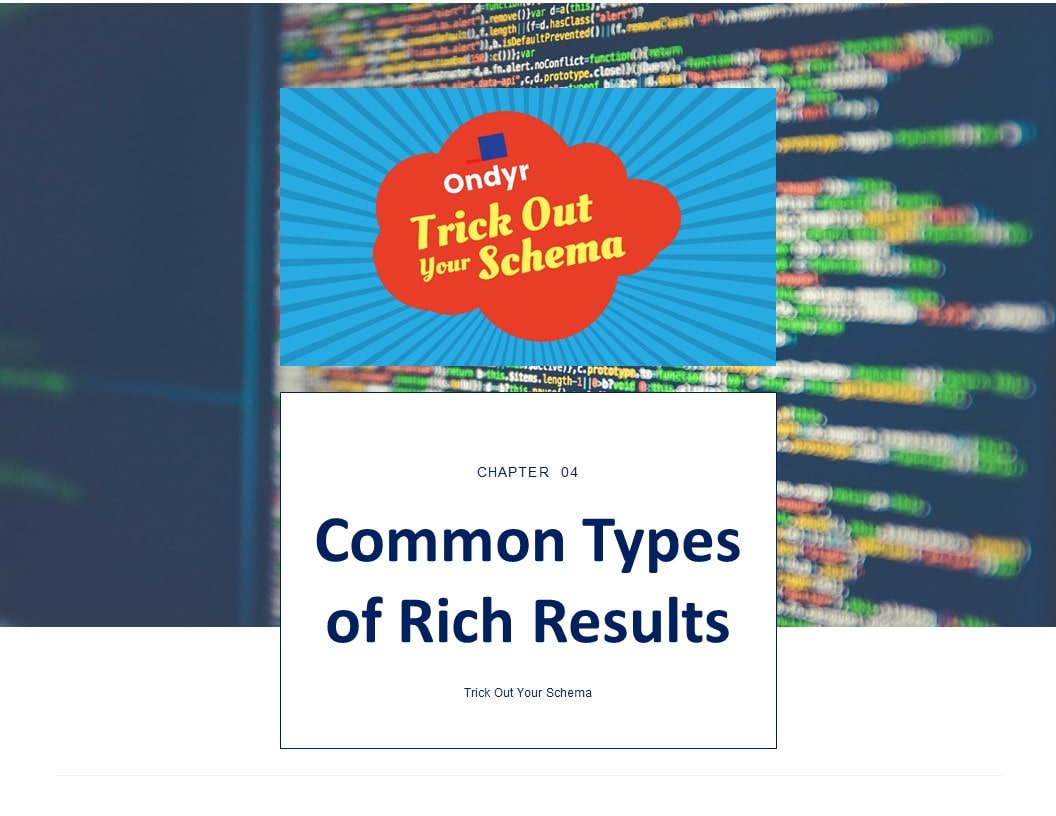
Recipes
Recipe rich results show an image of the dish, prep time, cook time, nutrition information and more. In mobile, these rich results can earn a spot in the prominent recipe carousel which is often on the top of mobile recipe search results.

Here’s a similar recipe without schema to highlight the difference:

You say the enchiladas are delicious, but we’ll believe you when we see a picture of it!
Events
Event schema will make you eligible to show up for the top events box which is prominently displayed in Google results.
It can also turn a regular four-line search listing into a much longer result with up to three additional lines for upcoming events, such as the next three concerts for a local concert venue.
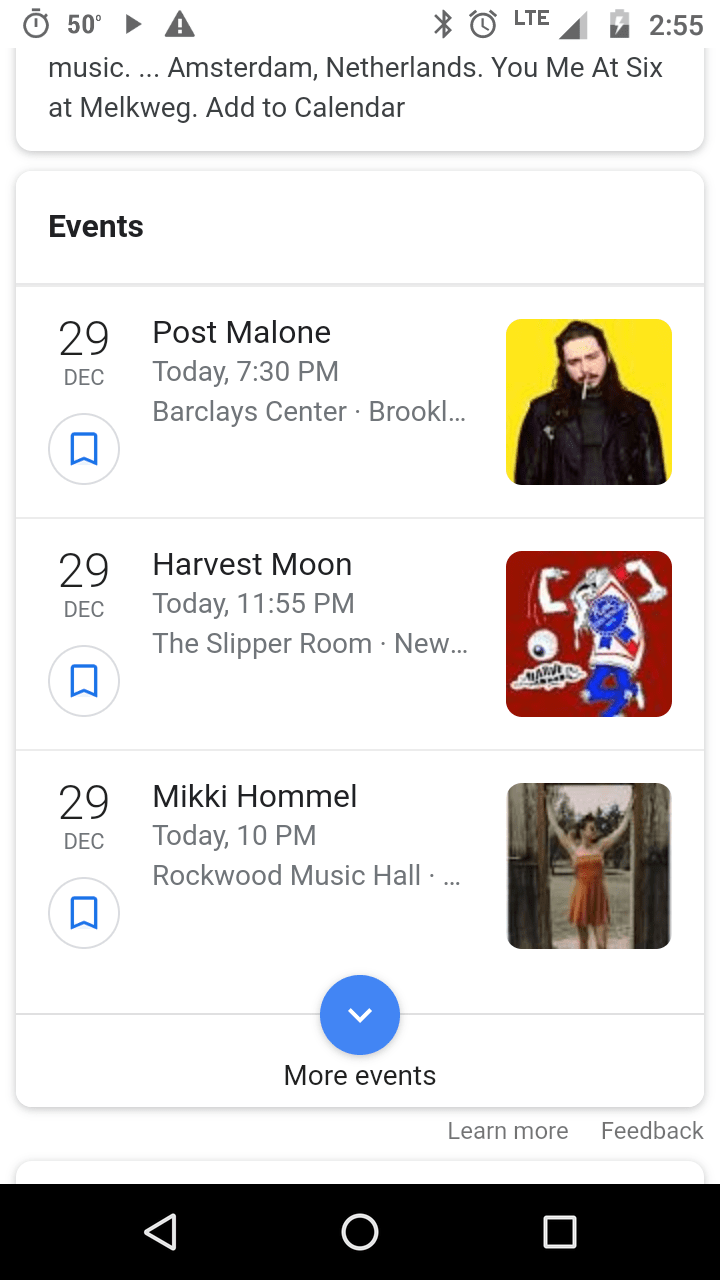
Example of Event Schema
Maybe Post Malone isn’t your style. Do you want to build a snowman instead?
How about singing about building a snowman?
If so, Google can point you towards the nearest Frozen festivity!

Articles
Article rich results are another example of schema markup than can apply to a wide variety of sites. You can markup any article or blog post with this schema, which makes you eligible for the top stories carousel with a featured image which is much more enticing for users to click on than a regular listing.

When it comes to the subways of New York City, there’s always a story.
Organization Graph
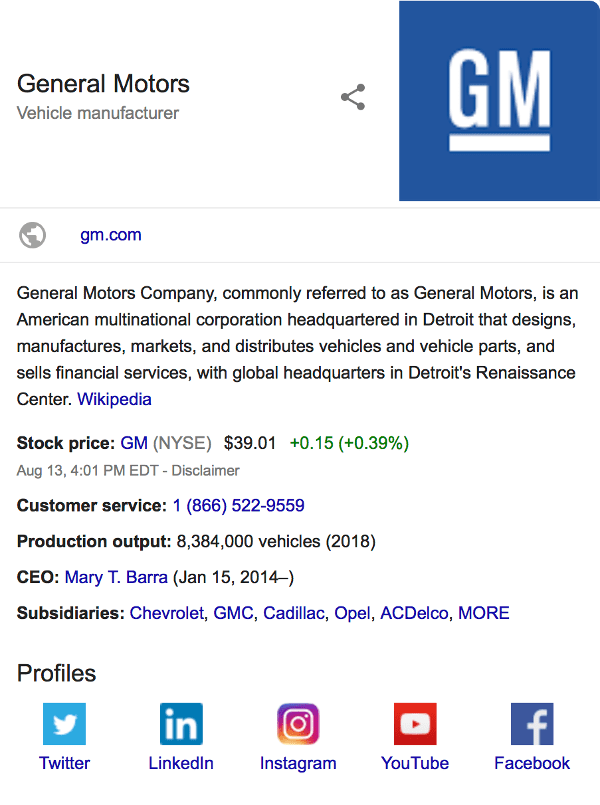
The corporate contact is typically seen in the prestigious knowledge panel alongside information often from Wikipedia (although having a Wikipedia page is not a requirement to get a knowledge panel).
The corporate contact schema can be included in the common organization schema along with other pertinent information like hours, social accounts, logo.
Like all markups, fill out your organization with as many relevant properties as possible. The organization graph is one of the more difficult rich results to get as it requires a certain level of industry recognition. It helps to have a Wikipedia page but this isn’t necessary.
Don’t confuse the local business listing with the knowledge panel (highlighted earlier) which is different but looks similar and is placed in a similar place. This can be a great chance to boost branding for your organization.
Job Postings
Jobs are showing up more and more on the front page of Google. Anyone hiring is trying to get the most qualified job applicants they can and this is a good way to support that effort.
For instance, Christmas will be here soon enough and it’s important that you hire the right Santa for the job.
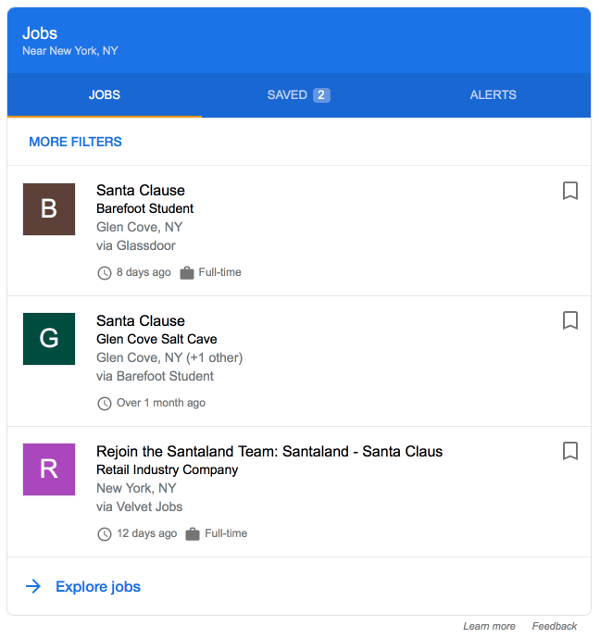
If you have job postings on your site, marking them up with the appropriate schema will make them eligible for a featured spot on Google, as seen above.
Local Business
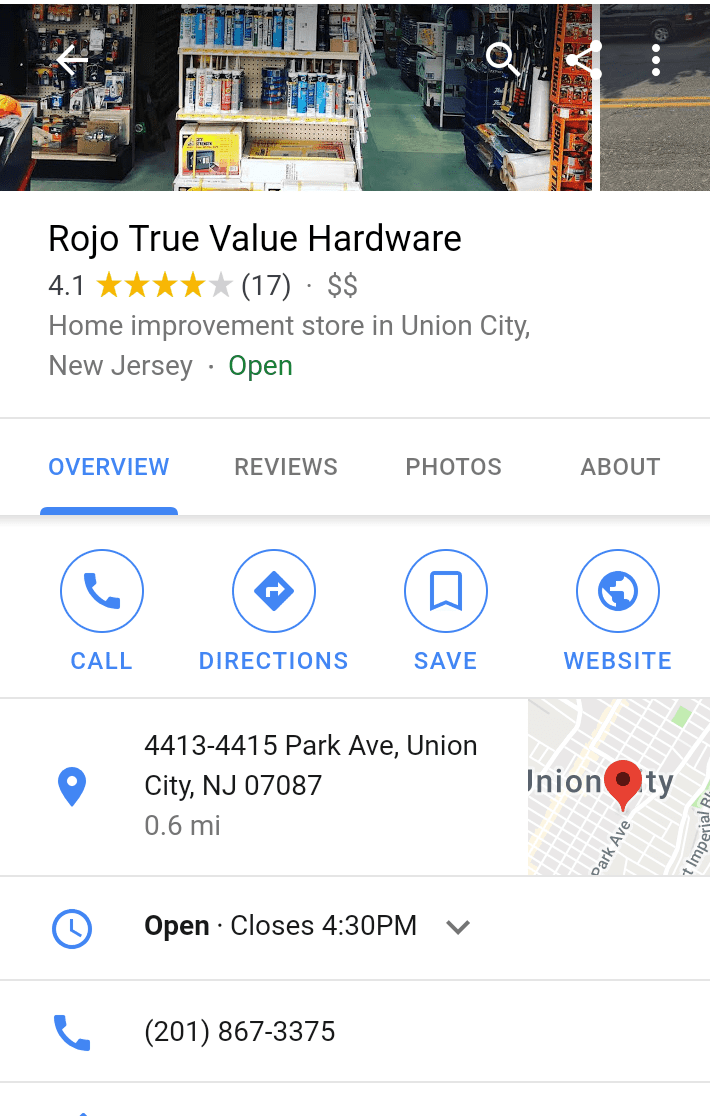
The local business rich result looks similar to the knowledge panel and is located in a similar place on mobile and desktop but don’t confuse the two. This is easier to get than a knowledge panel.
Most local businesses should be able to see a result like the one above if they have good schema markup along with a Google My Business account.
Make sure both are filled out completely and, most importantly, that the information matches. This will give more confidence to Google that the information is correct, increasing the likelihood that it appears in search results listings.
The local business listing can display a map, along with other pertinent information, such as a phone number, website, and any reviews (if applicable).
Product Reviews
Product schema is a very common rich result. For any Amazon result showing in Google, you will see this rich result in effect. They feature a prominent image, rating stars and often an “in-stock” callout.

As you can see, at 4.2 stars, dressing up your chihuahua as a Paris Hilton for Halloween is clearly a win-win for mankind.
Reviews of either a product, creative work, or even a blog post are a common rich result found in Google. For compliance purposes, it’s required that your site has a mechanism for collecting ratings to use this particular schema markup.
You can’t use Yelp or Google ratings as the source of your average rating markup. This is against Google Guidelines and can get you penalized for spammy schema.
The example above highlights schema implemented on Amazon’s website, but we’ve included Google’s carousel of shopping results because the visual was just too good to leave out.
Other Rich Results in Google
Check out our post on 30 Rich Results in Google powered by Schema to see examples of all 30 rich results that are currently featured in Google, which include:
- Book
- Breadcrumb
- Carousel
- Course
- Critic Review
- Dataset
- Employer Rating
- FAQ (Frequently Asked Questions)
- Fact Check
- How-to
- Livestream
- Logo
- Media Actions
- Occupation
- Q&A Page
- Sitelinks Search
- Social Profile
- Software App
- Speakable
- Subscriber content
- Top Places List
- Video
Chapter 5: SEO Benefits of Schema and Structured Data
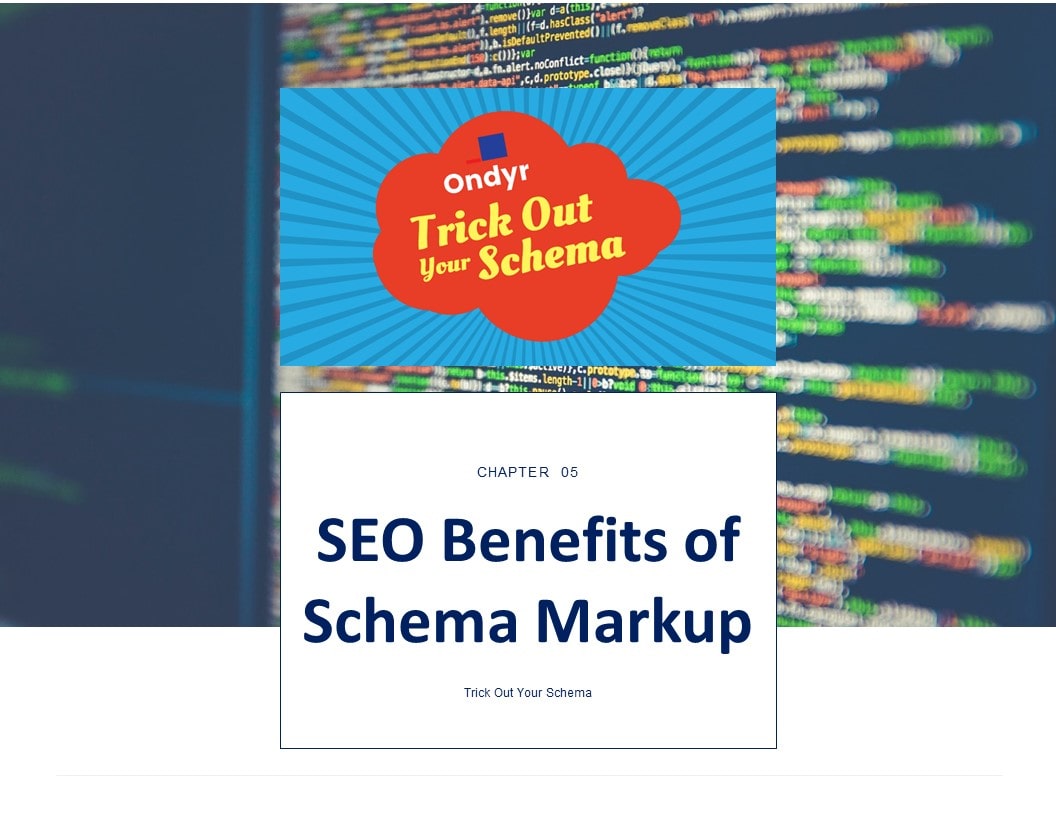
1. Help search engines understand your site better
Schema markup helps search engines to understand websites better by using metrics that allow algorithms to rank results appropriately - the purpose of SEO. For example, meta descriptions, title tags, alt text and many other properties have little effect on the front-end but are important for SEO. Therefore, even if a specific schema markup doesn’t lead to a rich result, it’s still highly recommended that you implement it.
2. Improve your brand presence in search
Knowledge Panels and Local Business Listings are the best ways that rich results powered by schema can lead to better brand presence. This is achieved in offering the ability for visual aspects of branding to be incorporated into product search results. Markups like rating stars offer great social proof. Overall, the more information about your brand that’s shown in Google, the better.
3. Increase click-through-rate with visually enhanced results
A study by CXL showed that review stars in search engine results significantly improve click-through rates (CTR) by as much as 35 percent.
According to a study conducted by Botify, product pages with ‘In Stock’ rich results see an increased CTR of 5-10% (while ‘Out of Stock’ results decrease CTR). Similarly, 5-star ratings increase CTR drastically while ratings with 3-stars or less decrease CTR.
4. Improve your ranking position
Schema markup can also improve your actual organic listing position in certain situations. John Mueller, the Senior Webmaster Trends Analyst at Google, confirmed that it could help rankings when targeting is involved.
“SD [Structured Data] can make it easier to understand what the page is about, which can make it easier to show where it’s relevant (improves targeting, maybe ranking for the right terms). ”
-John Mueller, Senior Webmaster Trends Analyst, Google
5. Optimize for voice search, Alexa, and Google Assistant
If you look at articles on recent SEO trends, voice search is almost undoubtedly on the list, and more importantly, voice answers. There’s a specific kind of schema markup, called Speakable, which is geared towards areas of your website suitable for voice-related tasks.
Even common schema, like schema for recipes, allows your data to be structured in a way that makes it easier for Google to use your site’s information in a voice answer, even if you don’t use the Speakable schema.
Instead of a free-form recipe that requires Google to guess the preparation steps, you can provide structured data that explicitly lists the recipe’s instructions, ingredients, cook time, etc. This is very helpful when you’re elbows deep in preparing a new dish for the first time.
Alexa! Please send an S.O.S. to chefs in the area! I’m in need of assistance!
You can also create a skill in Alexa or Google Assistant directly to be featured in voice answers.
In many ways, optimizing for voice search is very similar to regular SEO since you want to snag the first result spot or even better - the featured snippet (position zero). Getting to the top is paramount in voice search as answers typically return only one result, the top one.
6. Unlock More Space in Search Results
Another benefit is that rich results powered by schema markup will give you more space in the search results listings.
For example, we mentioned events with rich results often add three lines to your organic search listings. Google is the most important search engine (obviously) and getting organic space is at a premium. Gaining more real estate without paying for advertising is a huge advantage.
It’s mission-critical to get onto the first page of Google’s search results because no self-respecting thumbs are clicking through to Page Two.

Chapter 6: Client Case Study – Angelic Bakehouse

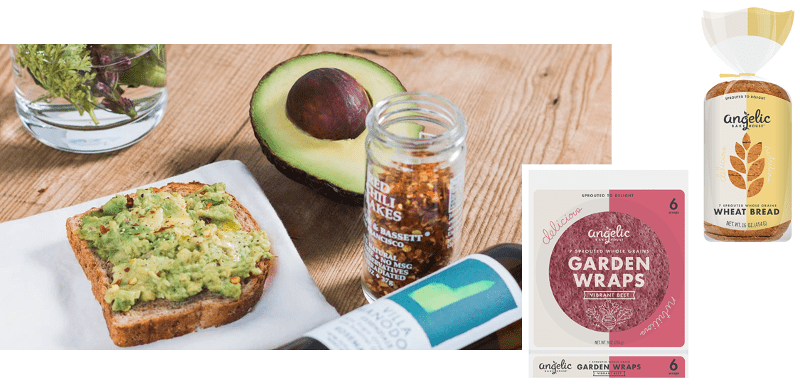
Angelic Bakehouse, a sprouted grain bread company that sells its products nationwide in stores like Whole Foods and Costco, brought on Ondyr to lead the SEO efforts of their recent site launch.
At the point Ondyr came onboard the project, the website was close to being finalized. Unfortunately, the URL format had changed for recipes and it was too late to change. While the previous site had “/recipe” category included in the URL format, the new URL format removed the “/recipe.” Additionally, competing recipes in SERPs featured rich results, making it difficult for Angelic Bakehouse to draw attention with a basic text listing. After the site launch, the traffic to the recipe pages, a major source of search traffic, tanked.
Since schema markup is a great way to help search engines understand page content, Ondyr added schema to all of Angelic Bakehouse’s recipe pages with relevant information, such as cooking instructions, ingredients, and prep time.
Almost immediately, Angelic Bakehouse’s traffic recovered and the newly marked-up recipe pages saw traffic increases ranging from 70 to 400 percent! Clearly, telling Google this was a recipe through schema made up for the lack of ‘/recipe’ in the URL.
Also, Angelic Bakehouse won rich results for all of its recipe listings with images and prep time callouts. This further increased CTR and subsequently, traffic. Lastly, the schema led to many recipes to be featured in the prominent recipe mobile carousel which also helped drive traffic from mobile searches tremendously.
Conclusion: Schema is the Trend You Can’t Skip
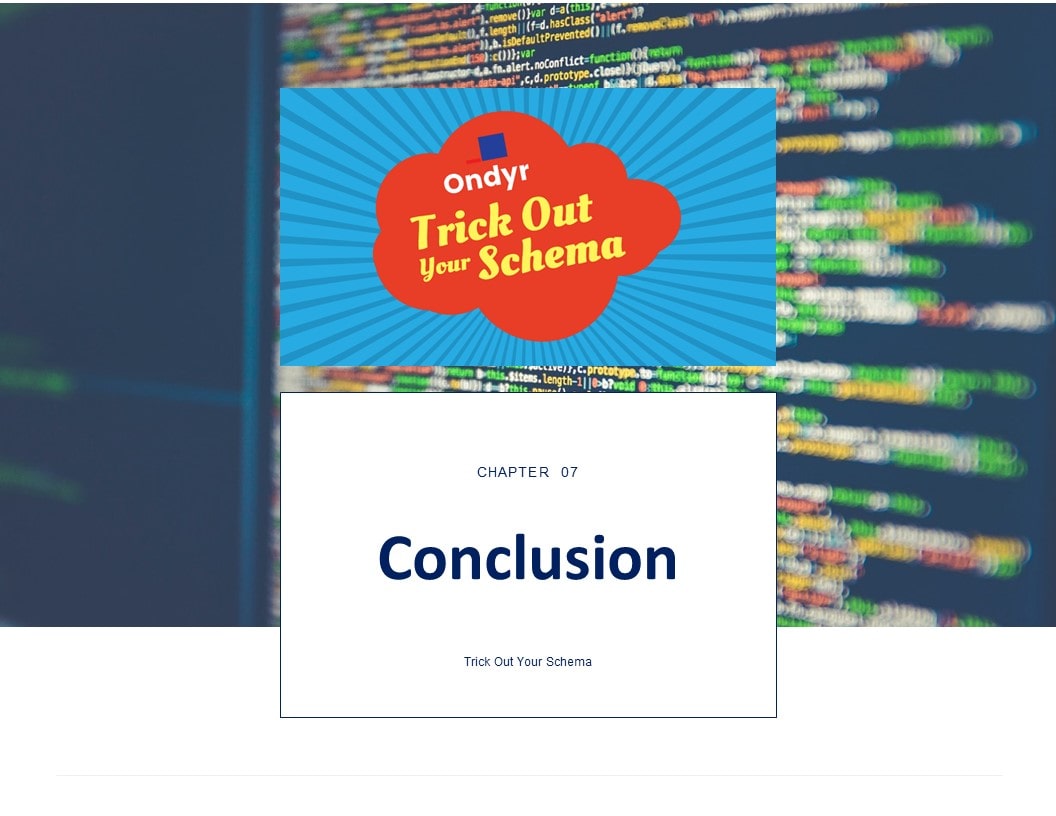
We hope that you enjoyed our overview of schema markup and structured data for SEO, along with our tips for tricking out your website with schema to land better search results.
As you now know, there are many types of schema markup and oodles of benefits that come with incorporating it into your SEO strategy - like landing the coveted position zero spot, ranking higher on Google, appearing in search queries, and catching the attention of scrolling thumbs with flashy schema bling. It is a critical part of On-SERP SEO.
Download our Schema Resources Guide to get our list of 15 top curated schema resources to keep you cruising into a deeper understanding of schema markup and SEO best practices. Make sure to check out our blog post on Getting Started with Schema Markup which covers beginner, intermediate, and advanced ways to implement schema markup for structured data to trick out your search results.
There’s never been a better time to leverage the power of schema markup, so we recommend that you get going with implementing it and know that Ondyr is here to help!
Ondyr offers a range of SEO and technical marketing services and brings a wealth of expertise on how to most effectively implement schema markup to drive meaningful results.
Book a Free one-on-one Schema Strategy Session with us to learn how you can take your search results from looking like the used Camry you drove in high school to a brand new Lamborghini.
With schema markup, your search results will be turning heads and catching clicks!
About the authors
Stephen Stanczak
Principal, Ondyr
Ondyr is a digital marketing firm focused on Search Engine Marketing, with a specialization on schema markup.
Stephen has worked on several digital marketing campaigns for companies such as Microsoft, GE and various SMBs. Stephen holds marketing degrees from Temple and Cornell University. He has spoken at Techstars, Baruch College, Techhub NYC, SEMrush Live, and Grand Central Tech. To connect, visit Ondyr.com.
Caroline Cooke
Founder, Bright Humor
Bright Humor is a creative consultancy helping brands to develop thought-provoking, high-impact marketing communications that capture attention, strengthen audience engagement, and inspire meaningful action.
Founder Caroline Cooke collaborates with both agency and in-house marketing teams to identify strategic opportunities to leverage ‘Professional Meets Playful’ humor. To learn how Bright Humor can boost your business, visit www.brighthumor.com or email [email protected].

